Culinary Herbs to Plant This Fall
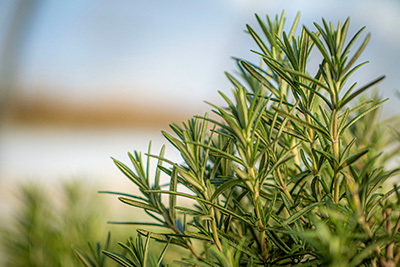
Herbs are nature’s contribution to culinary delights, used widely around the world to add bold, savory, sweet, or spicy flavors to a dish. Herbs also hold cultural significance—the aroma might elicit memories of family traditions and recipes passed down from generations. When those herbs are homegrown, they can instill a connection to nature and serve as a sustainable and cost-effective alternative to store-bought herbs. Here are some herbs to plant this fall season to add fresh flavors to your cooking.
Rosemary
Rosemary (Salvia rosmarinus) is a fragrant evergreen herb with small, needle-like leaves. Its strong flavor can be found in bread, pasta, and meat dishes and seasoned on potatoes and other vegetables. It requires full sun and maintains a high drought tolerance, so it performs well in the hot Florida climate. Rosemary is disease and pest resistant and grows as a woody perennial or small shrub. It can reach up to 6 feet tall and 4 to 5 feet wide, but careful pruning can keep it in check. It can thrive in Florida year-round, although protective measures should be in place during freezes. It is recommended to buy rosemary from a garden center since it can be difficult to start from seed.
Thyme
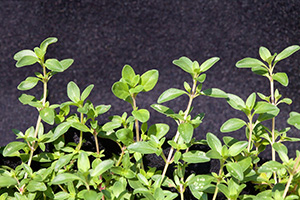
Thyme (Thymus vulgaris) is an evergreen perennial whose leaves are often used in spice combinations such as Cajun or Creole seasonings. It can add flavor to soups, stews, meats, and vegetables. It is drought tolerant and easy to manage, preferring full sun. It should be trimmed back whenever it gets leggy and in early spring and summer to reduce woody growth and maximize culinary use. It can grow to 6 to 8 inches tall and spread 6 to 16 inches wide. Harvest as needed during the growing season and just before it flowers. Thyme is excellent at retaining its flavor when dried, making it suitable for storage.
Parsley
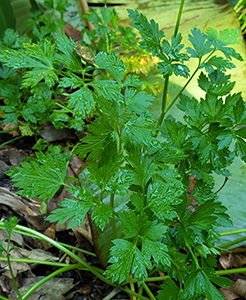
Parsley (Petroselinum crispum) is a bright green, versatile herb commonly used fresh as a garnish for soups and salads or in seasonings. There are three common varieties of parsley: flat leaf, curly leaf, and parsley root. Flat leaf, or Italian parsley, is the most popular and tends to have the strongest flavor while curly leaf has excellent decorative leaves. Root parsley, or ‘Hamburg’ parsley, has white roots that resemble young parsnips and can be cooked or eaten raw. Parsley typically grows in Florida as a cool-season annual and prefers light shade away from the intense afternoon sun. Planting by seed can be difficult—they generally take 7 to 12 days to germinate. Soaking the seeds overnight in water before planting can enhance their success. The plant can grow 8 to 12 inches tall and 8 to 12 inches wide, making it a relatively small herbaceous plant. Be sure to prune regularly, pinch off the flower buds (if growing for culinary use), and avoid cutting more than one-third of the plant at a time.
Sage
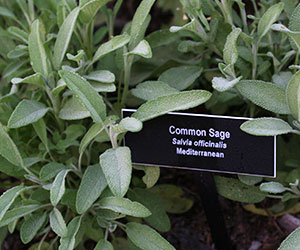
Sage (Salvia officinalis) is an evergreen perennial shrub whose leaves can add a warm, earthy flavor to dishes. It can easily be started from seed and grows up to 2 feet tall and 2 to 3 feet wide, offering plenty of leaves for harvesting. It is important to water deeply and infrequently but be sure to have proper soil drainage to avoid root rot. Sage thrives off full sun exposure, which ensures healthy plant growth and strong flavors. Pruning throughout the growing season is crucial to promote new growth; if you are using sage for culinary purposes, flower buds should be removed as soon as they appear.
Cilantro
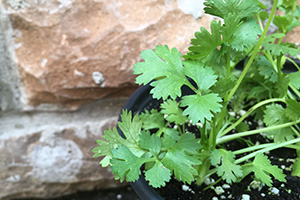
Cilantro (Coriandrum sativum) is a unique, pungent herb that works well in cuisines from around the world. While cilantro to some is an ideal ingredient for their tacos or guacamole, to others it might taste “soapy”. If your tastebuds have a positive response to cilantro, then this widely used herb might be a nice addition to your garden. Both the leaves and seeds can be harvested—when the leaves are used, the herb is referred to as cilantro, but when the seeds are used, the herb is referred to as coriander. The seeds form about three months after planting and can be used whole or crushed for cooking purposes; they are popular in both sweet and savory dishes. The plant can be grown from seed or transplants and can be harvested when the plants reach 6 inches tall, and continuously thereafter.
Garlic
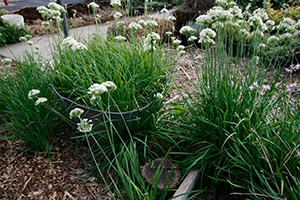
Many people find garlic (Allium sativum) to be a staple in their kitchen. The robust spice finds its way into many recipes, adding a kick of flavor. The plant has an onion-like appearance with white to purplish bulbs. The bulbs, covered in a papery exterior, can be separated into sections (edible cloves) and diced or crushed for cooking. Garlic is most commonly grown via propagation when a new sprout emerges from an individual clove. Varieties like Artichoke and Creole are well suited for Florida gardens. Garlic must be watered and fertilized on a regular basis. Harvest your garlic when about half the leaves have dried and bent towards the ground. It’s important to allow the bulbs to dry out for a few days before cooking by placing them in a well-ventilated spot with bright, indirect light. Then, cut off the leaves and store the bulbs in a cool, dark place until you are ready to cook them.
Basil
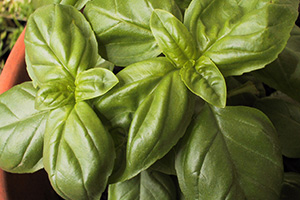
Basil (Ocimum spp.) is a versatile herb and is often used in Italian, Asian, and other cuisines. Its popularity around the world stems from its fresh, spicy taste and aroma. Basil varieties can be grouped into four main categories: sweet green, dwarf green, purple-leaf, and scented leaf. Most basils are annuals in Florida, but a few are perennials. It grows well in our warm climate and can be planted in early spring or fall, but be sure to protect it from frost—leaves will turn black and fall off when temperatures reach below 40°F. Basil succeeds in containers or gardens and prefers partial-sun conditions. The plant needs moist but well-drained soil, which can be regulated using mulch. If using basil for cooking, pinch off flowers as they form to prolong leaf harvesting.
Growing herbs this fall season sets up your kitchen for fresh, unique flavors from your garden, patio, or windowsill. Planting a variety of herbs makes for a more expansive culinary experience, one that connects you to culture, people, and the environment. There is nothing like fresh herbs to top off a dish and the gratification of knowing exactly where they came from.
Also on Gardening Solutions
- Basil
- Cilantro
- Five Herbs for December
- Garlic
- Herbs in the Florida Garden
- Parsley
- Rosemary
- Sage
- Thyme
